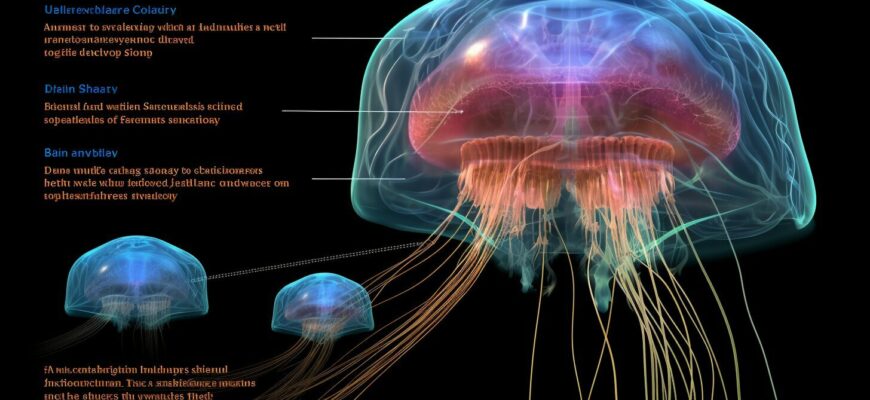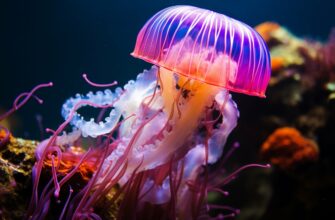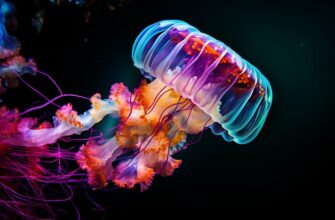Welcome to our article on jellyfish anatomy! Jellyfish are fascinating creatures that are known for their unique biology. One of the questions that often comes up is whether or not jellyfish have hearts. In this article, we will explore the anatomy of jellyfish and answer this question in detail.
- The Anatomy of Jellyfish
- Circulatory System in Jellyfish
- How Does the Circulatory System Work?
- Do Jellyfish Have Hearts?
- Jellyfish Fluid-Filled Cavity
- How Jellyfish Circulate Fluids
- Other Adaptations for Survival
- Fascinating Facts About Jellyfish
- Frequently Asked Questions (FAQ) about Jellyfish Anatomy
- Do jellyfish have brains?
- How do jellyfish reproduce?
- What is a jellyfish’s stinging mechanism?
- Can you eat jellyfish?
- Do jellyfish have a respiratory system?
- What is the lifespan of a jellyfish?
- Why do jellyfish glow in the dark?
- Can jellyfish see?
The Anatomy of Jellyfish
Jellyfish, also known as jellies, are fascinating creatures with unique biology. They belong to the phylum Cnidaria, which also includes coral and sea anemones. The anatomy of a jellyfish is quite different from that of most other animals.
At the core of a jellyfish is a soft, gelatinous bell-shaped body, known as the medusa. The medusa is usually translucent and can come in a variety of shapes, such as domed or flattened. From the base of the medusa, long, slender tentacles extend outward.
| Body part | Description |
|---|---|
| Medusa | The main body of the jellyfish, which is bell-shaped and can come in various forms |
| Tentacles | Long, slender appendages that extend outward from the base of the medusa |
The tentacles are lined with thousands of tiny, stinging cells called nematocysts, which the jellyfish uses for defense and to capture prey. Inside the medusa is a fluid-filled cavity called the gastrovascular cavity, which acts as both a stomach and a circulatory system.
Jellyfish do not have a centralized nervous system like most animals, but they do have a simple network of nerves that allows them to sense their environment and react accordingly. They also have a unique circulatory system that relies on muscular contractions to move fluids throughout their body.
Circulatory System in Jellyfish
Jellyfish have a unique circulatory system that differs significantly from that of humans. The system is not based on a traditional heart but rather on a series of canals that are responsible for circulating fluids throughout the jellyfish’s body.
This system is known as the gastrovascular system, and it consists of a series of canals that run throughout the jellyfish’s bell, along with a network of branching canals that extend into the tentacles. These canals are lined with cells that have tiny hair-like projections, known as cilia, that help to move fluids along.
| Gastrovascular System | Function |
|---|---|
| Canals | Circulates fluids throughout body |
| Branching canals | Extend into tentacles to aid in feeding and toxin delivery |
| Cilia | Helps to move fluids along the canals |
The gastrovascular system serves several functions in the jellyfish’s body. It helps to transport nutrients and oxygen to all parts of the body, which is essential for survival. Additionally, the system helps with digestion. The jellyfish is able to use its body as a sort of stomach, breaking down food into smaller particles in the gastrovascular cavity before absorbing the nutrients into its body.
How Does the Circulatory System Work?
Jellyfish do not have a brain or a central nervous system. Instead, they rely on a series of nerve nets that run throughout their body. These nerve nets help to coordinate the movement of the muscular contractions that aid in the circulation of fluids.
As the muscle contractions push the fluids through the canals, the cilia help to create a current that moves the fluids along. This system is highly efficient, allowing jellyfish to circulate fluids throughout their bodies despite lacking a traditional heart.
Do Jellyfish Have Hearts?
One of the most fascinating aspects of jellyfish anatomy is their unique circulatory system, which begs the question: do jellyfish have hearts? While jellyfish do not possess a traditional heart like humans, they have a different mechanism for circulating fluids.
Jellyfish have a fluid-filled cavity called the gastrovascular cavity, which functions as both a circulatory and digestive system. The cavity is shaped like a ring and runs around the margin of the jellyfish’s bell-shaped body. It is lined with cilia, which are hair-like structures that help to move fluids through the body.
The gastrovascular cavity works through a process of muscular contractions, known as pulsations. These pulsations help to move fluid throughout the jellyfish’s body and also aid in the digestion of food. As fluid is pumped through the body, nutrients and oxygen are distributed to the jellyfish’s cells.
While jellyfish do not have a traditional heart, their unique circulatory system allows them to survive and thrive in their marine environment. In fact, jellyfish have been around for millions of years and have evolved a number of unique adaptations to help them survive in the ocean.
Jellyfish Fluid-Filled Cavity
One of the most unique features of jellyfish anatomy is their fluid-filled cavity, which is known as the gastrovascular cavity. This cavity serves multiple purposes, including digestion, reproduction, and circulation.
The gastrovascular cavity is lined with thousands of nutrient-absorbing tentacles that surround the jellyfish’s mouth, allowing it to capture and consume prey. Once the jellyfish has ingested its food, enzymes are secreted into the cavity, breaking down the food for absorption.
The gastrovascular cavity also plays a crucial role in the jellyfish’s circulation system, as it serves as the primary means for transporting nutrients, oxygen, and waste products throughout the body. The fluid within the cavity is circulated through muscular contractions, known as pulsations, creating a pressure gradient that moves fluids throughout the body.
Thanks to this unique adaptation, jellyfish are able to survive in a wide range of ocean environments, despite their simple anatomy. Their fluid-filled cavity helps them to distribute vital nutrients and oxygen and eliminate waste products efficiently, allowing them to thrive in even the most challenging marine ecosystems.
How Jellyfish Circulate Fluids
Jellyfish do not have a traditional heart like humans, but they have an equivalent mechanism for circulating fluids throughout their body. This is achieved through muscular contractions, known as pulsations, which help move fluids around their bodies.
The main cavity in a jellyfish’s body is the gastrovascular cavity, a fluid-filled chamber that serves as both a digestive system and a circulation system. The walls of the gastrovascular cavity are lined with tiny hair-like structures called cilia, which help move the fluid around the cavity.
The pulsations of the jellyfish’s bell-shaped body also help circulate the fluid. As the jellyfish contracts its body, it forces fluid out of the gastrovascular cavity and into the surrounding ocean. This fluid then diffuses oxygen and nutrients to the jellyfish’s tissues before being absorbed back into the gastrovascular cavity as the jellyfish relaxes its body.
The gastrovascular cavity also aids in digestion, as enzymes secreted by the lining of the cavity help break down food particles. Waste is then expelled through the same opening where food enters the cavity.
The combination of the gastrovascular cavity, cilia, and pulsations allows jellyfish to efficiently circulate fluids and obtain nutrients throughout their body.
Other Adaptations for Survival
In addition to their unique circulatory system, jellyfish have other fascinating adaptations that help them survive in their marine environments.
One such adaptation is their simple nervous system. Jellyfish do not have a brain like humans, but instead have a network of nerves located in their bell, which allows them to detect changes in their surroundings and react accordingly. This is particularly important for avoiding predators and finding food.
Jellyfish also have the ability to regenerate lost body parts. If a jellyfish loses a tentacle or even a portion of its bell, it can often regrow the missing piece over time. This is a valuable adaptation in an environment where they may encounter predators or obstacles.
Another interesting aspect of jellyfish biology is their bioluminescence. Many jellyfish species are able to produce their own light through chemically reactive cells in their bodies. This can serve as a method to attract prey or confuse predators in the dark depths of the ocean.
Overall, the unique biology of jellyfish has allowed them to thrive in a wide variety of marine environments, adapting to challenges and developing fascinating survival mechanisms along the way.
Fascinating Facts About Jellyfish
Jellyfish are among the oldest living creatures on the planet, with fossils dating back to the Prehistoric era.
There are more than 2,000 species of jellyfish, ranging in size from a few millimeters to over 2 meters in diameter.
Contrary to popular belief, not all jellyfish sting humans. Only a small number of species have tentacles with venom that can be harmful to humans.
Jellyfish are an essential part of marine ecosystems, serving as both predator and prey. They are food for animals such as sea turtles and some species of fish, while also feeding on plankton and small fish themselves.
Jellyfish have a unique biological adaptation that allows certain species to reverse their life cycle, transforming from adult jellyfish back into juvenile polyps.
Despite their simplicity, jellyfish have some fascinating abilities. They are able to detect light, respond to touch and gravity, and even use bioluminescence to attract prey and communicate with other jellyfish.
The lifespan of a jellyfish can vary greatly depending on the species and environmental factors. Some live for only a few hours, while others can survive for several years.
Jellyfish have the ability to regenerate, meaning that they can regrow lost body parts such as tentacles or even their entire body under certain conditions.
While jellyfish do not have a brain like humans, they do have a simple neural network that helps them process sensory information and coordinate their movements.
Finally, jellyfish have become a popular subject for artists and photographers due to their otherworldly appearance and fascinating biology. Their pulsating movements and iridescent colors can create mesmerizing displays in the water.
Frequently Asked Questions (FAQ) about Jellyfish Anatomy
Have a question about jellyfish anatomy? Check out some of the most commonly asked questions and their answers below.
Do jellyfish have brains?
No, jellyfish do not have brains like humans do. Instead, they have a very simple nervous system that allows them to detect light and movement.
How do jellyfish reproduce?
Jellyfish have a unique reproductive process that involves both sexual and asexual reproduction. They release eggs and sperm into the water, which combine to form larvae that eventually grow into adult jellyfish. They also have the ability to reproduce asexually by budding, where a small piece of the jellyfish breaks off and grows into a new individual.
What is a jellyfish’s stinging mechanism?
Jellyfish use specialized cells called nematocysts to sting their prey or protect themselves from predators. These cells contain tiny harpoons that shoot out when triggered, releasing toxins that can paralyze or kill their target.
Can you eat jellyfish?
Yes, jellyfish are considered a delicacy in some cultures and are served in dishes such as salads or stir-fries. However, it’s important to note that not all species of jellyfish are edible, and some can be toxic to humans.
Do jellyfish have a respiratory system?
No, jellyfish do not have lungs or gills like humans and other vertebrates. Instead, they absorb oxygen from the water through their thin skin.
What is the lifespan of a jellyfish?
The lifespan of a jellyfish varies depending on the species, but most live for only a few months to a few years. However, some species have been known to live for several decades.
Why do jellyfish glow in the dark?
Some species of jellyfish have bioluminescent cells that allow them to glow in the dark. This is thought to be a defense mechanism, as predators may be confused by the bright light and have trouble finding the jellyfish.
Can jellyfish see?
No, jellyfish do not have eyes like humans and other vertebrates. However, they can sense light and movement through specialized cells called photoreceptors.









